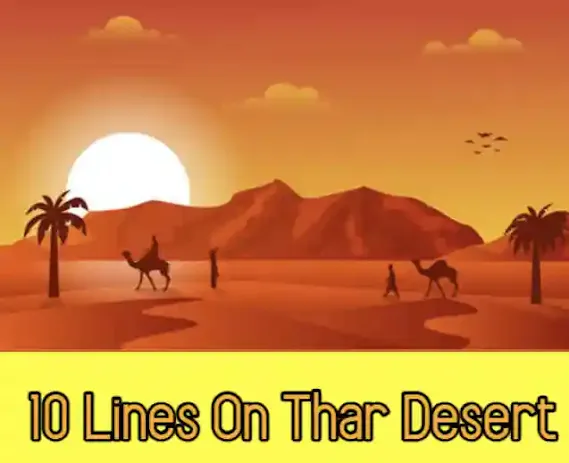10 Lines On Thar Desert for Class 1
1. The Thar Desert is a big sandy place in India.
2. It's also called the Great Indian Desert.
3. The Thar Desert is very hot and dry.
4. It has lots of sand and not much water.
5. Many animals and plants live in the Thar Desert.
6. Camels are often seen in the desert, walking on the sand.
7. People who live there wear special clothes to stay cool.
8. Some houses in the Thar Desert are made of clay to keep them cool.
9. The desert is a beautiful place with big dunes and clear skies.
10. The Thar Desert is a special part of India, loved by many people.
10 Lines On Thar Desert for Class 2
1. The Thar Desert is a big sandy area in India.
2. It's known for its hot weather and sandy dunes.
3. The Thar Desert is also called the Great Indian Desert.
4. Many camels live in the Thar Desert.
5. People wear special clothes to protect themselves from the sun and sand.
6. Some houses in the Thar Desert are made of mud and straw.
7. The desert has many beautiful plants and animals.
8. People use camels to travel across the sandy desert.
9. The Thar Desert is an important part of India's landscape.
10. Even though it's hot and dry, the Thar Desert is home to many living things.
10 Lines On Thar Desert for Class 3
1. The Thar Desert is a large desert in the northwest part of India.
2. It is also known as the Great Indian Desert.
3. The Thar Desert is characterized by its sandy landscape and extreme temperatures.
4. Many unique plants and animals, such as camels and desert foxes, live in the Thar Desert.
5. People who live in the Thar Desert have adapted to the harsh conditions by wearing light, loose clothing and living in houses made of mud.
6. Despite its arid environment, the Thar Desert experiences some rainfall, supporting life in the region.
7. The desert is home to several beautiful sand dunes, some of which can reach impressive heights.
8. The Thar Desert has a rich cultural heritage, with vibrant folk music, dance, and art.
9. It is an important tourist destination, attracting visitors who come to explore its unique landscape and learn about its culture.
10. While the Thar Desert can be challenging to live in, it is also a fascinating and beautiful place with its own distinct charm.
10 Lines On Thar Desert for Class 4
1. The Thar Desert is a vast desert located in the northwest region of India.
2. It is the largest desert in India and is also known as the Great Indian Desert.
3. The Thar Desert is characterized by its sandy terrain, with stretches of sand dunes and rocky areas.
4. Despite its arid climate, the Thar Desert supports a variety of plant and animal life, including several species of cacti, camels, and desert foxes.
5. People who live in the Thar Desert have adapted to the harsh conditions by building houses made of mud and wearing loose, light-colored clothing to stay cool.
6. The Thar Desert experiences extreme temperatures, with scorching hot days and cold nights.
7. Water is scarce in the Thar Desert, and many villages rely on wells and underground reservoirs for their water supply.
8. The desert is home to several oasis areas where water is more readily available, providing a lifeline for both people and wildlife.
9. The Thar Desert has a rich cultural heritage, with colorful festivals, traditional music, and dance forms that reflect the local way of life.
10. Despite its challenges, the Thar Desert is a beautiful and unique ecosystem that attracts visitors from around the world to experience its natural beauty and vibrant culture.
10 Lines On Thar Desert for Class 5
1. The Thar Desert, also known as the Great Indian Desert, is located in the northwest part of India.
2. It is one of the largest deserts in the world, covering an area of about 200,000 square kilometers.
3. The Thar Desert is characterized by its sandy terrain, with vast stretches of sand dunes and rocky outcrops.
4. Despite its arid climate, the Thar Desert supports a variety of plant and animal life adapted to survive in harsh conditions.
5. People who live in the Thar Desert have developed unique ways of life, including building houses made of mud and practicing traditional crafts.
6. Water is scarce in the Thar Desert, and many communities rely on wells, tanks, and reservoirs for their water supply.
7. The desert experiences extreme temperatures, with scorching hot days and chilly nights, especially during the winter months.
8. The Thar Desert is home to several unique species of wildlife, including the Indian gazelle, desert fox, and the endangered Great Indian Bustard.
9. It is also known for its rich cultural heritage, with vibrant folk music, dance forms like the Kalbelia, and colorful festivals celebrated throughout the year.
10. Despite its challenges, the Thar Desert is a fascinating and beautiful landscape, attracting tourists and researchers alike to explore its unique ecosystem and cultural treasures.
Also read: 10 Lines On Pratibha Patil In English
Also read: 10 Lines on Kailash Satyarthi in English
Also read: 10 Lines On Tiffin Box In English
Also read: 10 Lines Writing Good Habits Essay
Also read: 10 Lines on Tailang Swami Jayanti
Also read: 10 Lines on Tailang Swami Jayanti in Hindi
Also read: 10 Rules Of Chess Game in English
Also read: 10 Lines on the Bible for Children and Students
THANK YOU SO MUCH




is emotional abuse domestic violence in virginia
ReplyDeleteThe Thar Desert, one of the world's largest deserts, is a vast, arid region in India and Pakistan, characterized by sand dunes, sparse vegetation, and extreme temperatures. Despite challenges like water scarcity and sandstorms, it offers breathtaking natural beauty.